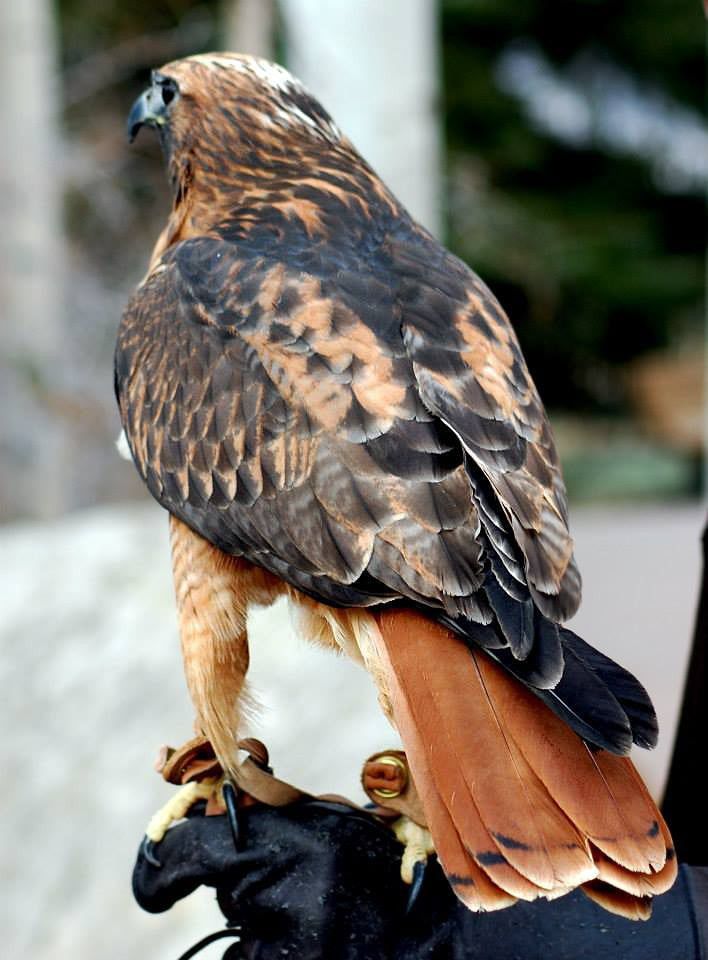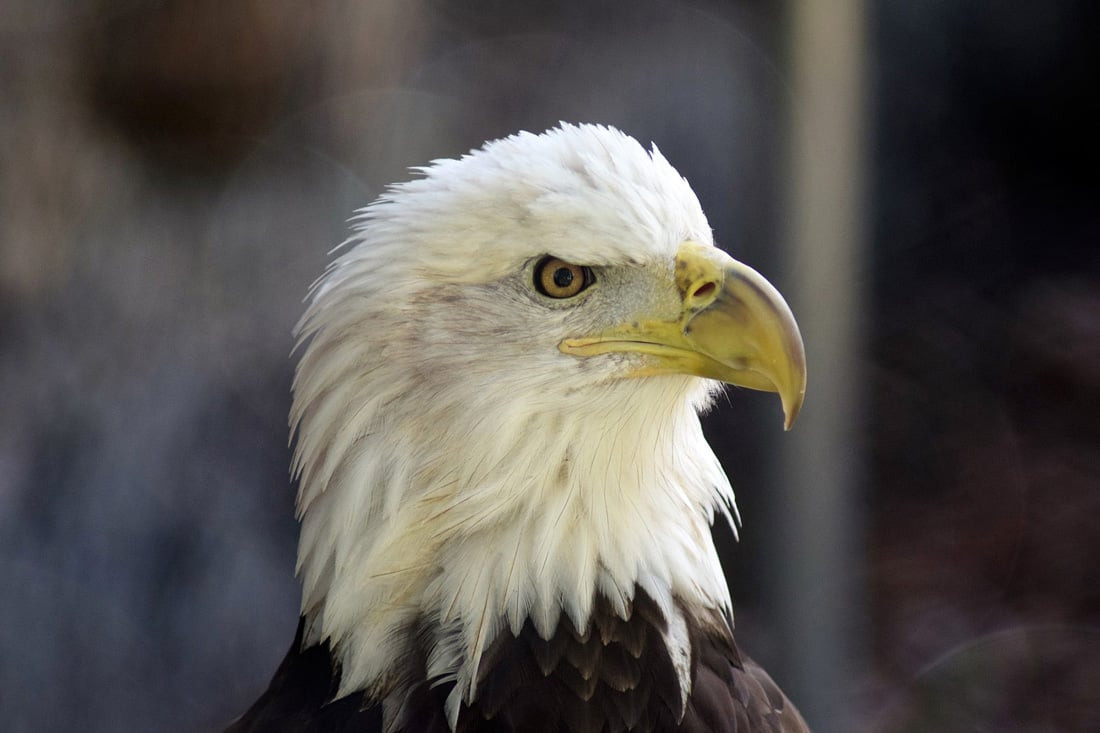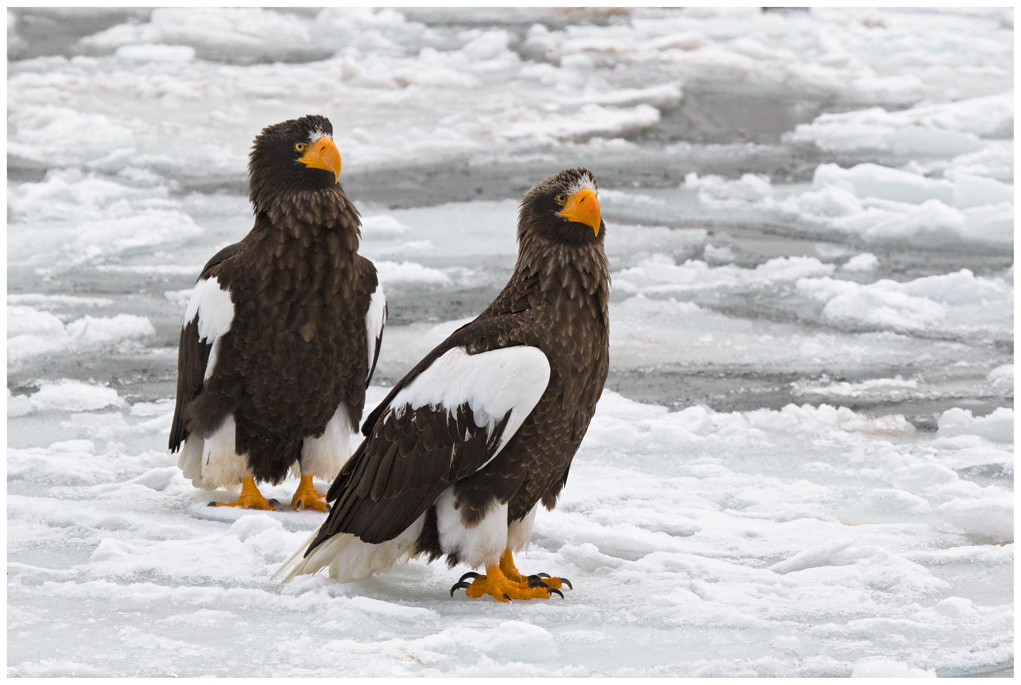Do you know what sounds an eagle really makes? Forget the Hollywood scream; the actual sounds of eagles are much more varied and interesting, and streetsounds.net is here to guide you through the diverse soundscapes of these majestic birds, providing you with authentic eagle sounds and urban soundscapes. Dive in to explore the unique calls of different eagle species, how they communicate, and how you can use these sounds in your creative projects.
1. Debunking the Myth: The Real Sounds of Eagles
Have you ever heard a soaring eagle in a movie and thought, “That sounds majestic”? Chances are, what you actually heard was the scream of a Red-tailed Hawk. Filmmakers often substitute the hawk’s call for the eagle’s, deeming the latter not “majestic” enough. This common misconception has led many to believe eagles sound completely different than they actually do.
 The Draper Museum Raptor Experience
The Draper Museum Raptor Experience
Isham, the Draper Museum’s Red-tailed Hawk. Learn more about Isham.
What Does a Red-Tailed Hawk Sound Like?
The Red-tailed Hawk is known for its piercing scream, a sound often used in film and television to represent eagles. However, this sound is distinctly different from the actual vocalizations of eagles. Red-tailed Hawks also produce other sounds besides their famous scream, adding to their vocal repertoire.
Where Can I Hear Authentic Red-Tailed Hawk Calls?
To hear authentic Red-tailed Hawk calls, visit eBird and click the green “Listen” button to the right and below the photo.
2. The Vocalizations of the Bald Eagle: America’s Symbol
While the Bald Eagle is a symbol of the United States, its calls might surprise you. These vocalizations are far from the dramatic screams often associated with eagles in popular media. Instead, they are a complex mix of high-pitched cries, chatters, and kuk-kuk-kuk sounds.
 A head shot of the Draper Museum Raptor Experience
A head shot of the Draper Museum Raptor Experience
Jade, the Draper Museum Raptor Experiences Bald Eagle. Learn more about Jade.
What Are the Different Types of Bald Eagle Calls?
According to Audubon, Bald Eagle vocalizations can be categorized as follows:
- Peal Call: High-pitched, prolonged, gull-like cries. Juvenile Eagles have their own peal and a chirping sound for begging food.
- Chatter Call: 3 – 4 introductory notes separated by short silences, followed by a rapid sequence of descending notes.
- Kuk-kuk-kuk Call: Females tend to have lower-pitched calls than males.
Where Can I Listen to Bald Eagle Vocalizations?
Listen to a few of these vocalizations here.
What Do Scientists Say About Bald Eagle Vocalizations?
According to Kussman (1977), nestlings use cheeping calls to beg for food, signal alarm, and communicate with parents. Dr. David A. Buehler (2000) notes that young Bald Eagles develop wail and peal calls around four weeks of age. The peal is a high-pitched cry, often described as sounding like a gull. Female Bald Eagles have a distinctive soft, high-pitched call when ready to mate, while males use a high-pitched peal to defend territory or ward off attacks.
Where Can I Find More Bald Eagle Sounds?
For additional Bald Eagle calls, visit this link and click “recordings” to the right side below the photo.
3. The Golden Eagle: A Chatty Raptor
The Golden Eagle, found across the Northern Hemisphere, is known for its beauty and strength. In the United States, they mainly reside west of the Mississippi. Interestingly, Golden Eagles are the national symbol of Mexico, Albania, Germany, Austria, and Kazakhstan.
 A head shot of the Draper Museum
A head shot of the Draper Museum
Kateri, the Draper Museum Raptor Experience’s Golden Eagle. Learn more about Kateri.
Are Golden Eagles Vocal?
Yes, Golden Eagles are quite vocal. They often make fairly quiet calls, especially during presentations. Though the exact meaning of these calls is unknown, they add to the eagle’s charm and captivate audiences.
Where Can I Hear Golden Eagle Calls?
Click here for calls and photos of Golden Eagles. For additional calls, visit this link and click the green “listen” button, or scroll down to “With Audio” or “Top audio.”
4. Steller’s Sea Eagle: The Barking Giant
The Steller’s Sea Eagle, one of the largest eagles in the world by weight, primarily resides in Russia, Korea, and Japan. Its impressive size, however, doesn’t translate to a majestic call.
 Two Steller
Two Steller
Steller’s Sea Eagles
What Does the Steller’s Sea Eagle Sound Like?
According to the San Diego Zoo, Steller’s Sea Eagles make a deep barking cry, described as “ra-ra-ra-raurau.” During breeding season, their calls resemble those of very loud seagulls.
Where Can I Listen to the Steller’s Sea Eagle?
Take a listen to this sound bite by clicking the green “listen” button on the right side.
5. Harpy Eagle: The Silent Hunter
In the Americas, the Harpy Eagle reigns as the largest eagle. The female can weigh nearly 20 lbs, making it one of the most powerful eagles in the world. Yet, despite its strength, the Harpy Eagle is not particularly vocal.
 Head shot of Harpy Eagle with head feathers raised.
Head shot of Harpy Eagle with head feathers raised.
Harpy Eagle
What Sounds Does the Harpy Eagle Make?
Harpy Eagles are known as the strong, silent types, not vocalizing very often. When they do, they produce sounds such as wails (wheee, wheee-ooooo), croaks, whistles, clicks, and mews.
Where Can I Hear Harpy Eagle Sounds?
Click the green “listen” button at this link. Then scroll down to “Statistics” where you can hear numerous sound bites. If you would like to learn some interesting facts about Harpy Eagles, this article provides 36 facts.
6. Philippine Eagle: A Rare Whistle
The Philippine Eagle, the largest eagle in the world in terms of length and wing surface, is extremely rare and the national bird of the Philippines. Its voice is described as a descending, whistled “weeuuuu!” repeated at intervals.
 A head shot of a Philippine Eagle.
A head shot of a Philippine Eagle.
Philippine Eagle
Where Can I Listen to the Philippine Eagle?
For photos and sounds, go here. Also, check out this Nat Geo Wild video clip, “Watch an Endangered Philippine Eagle Chick Grow up in Rare Video.”
7. Eagle Sounds in Urban Soundscapes: A Unique Blend
Have you ever considered how eagle sounds might blend with the sounds of the city? In urban areas near eagle habitats, the cries and calls of these birds can create a unique and compelling soundscape. Imagine the high-pitched peals of a Bald Eagle mixing with the honking of taxis or the chatter of a Golden Eagle echoing against skyscrapers.
How Are Eagle Sounds Used in Urban Environments?
In urban environments, eagle sounds can be used in various creative and practical ways. For example:
- Sound Art Installations: Artists can incorporate eagle vocalizations into installations, blending natural and urban sounds to create thought-provoking experiences.
- Educational Programs: Parks and nature centers can use these sounds to educate the public about local wildlife and conservation efforts.
- Film and Media: Filmmakers can use authentic eagle sounds to add realism to documentaries or fictional stories set in urban-wildlife interfaces.
8. How Streetsounds.net Enhances Your Sound Library
At streetsounds.net, we understand the importance of high-quality, authentic sound recordings. Our library includes a diverse range of eagle sounds, captured in various settings and contexts. Whether you’re a filmmaker, musician, game developer, or simply an enthusiast, our sounds can add depth and realism to your projects.
What Types of Eagle Sounds Does Streetsounds.net Offer?
- Bald Eagle Peals: Clear, high-pitched cries perfect for conveying freedom and majesty.
- Golden Eagle Chatters: Subtle, engaging calls that add a touch of wildness to any soundscape.
- Steller’s Sea Eagle Barks: Unique, deep vocalizations that capture the essence of this giant bird.
- Harpy Eagle Wails: Eerie, haunting sounds ideal for creating a sense of mystery and power.
- Philippine Eagle Whistles: Distinctive, melodic calls that bring a touch of the exotic to your projects.
How Can You Use These Sounds?
- Film and Television: Add realism to nature documentaries or create unique soundscapes for fictional scenes.
- Music Production: Incorporate eagle sounds into your tracks to add a layer of natural authenticity.
- Game Development: Enhance the immersive experience of your games with realistic wildlife sounds.
- Sound Therapy: Use calming eagle sounds to create relaxing and therapeutic environments.
9. The Intersection of Eagle Sounds, Music, and Art
Eagle sounds are not just for scientific study or wildlife documentaries. They can also be powerful elements in music and art, adding depth, texture, and a sense of place to creative works.
How Can Eagle Sounds Inspire Musicians?
Musicians can draw inspiration from the unique vocalizations of eagles to create innovative and evocative compositions. For example:
- Ambient Music: Incorporating the subtle chatters of Golden Eagles can create a calming, natural atmosphere.
- Electronic Music: Using the distorted wails of Harpy Eagles can add an eerie, unsettling texture to electronic tracks.
- Orchestral Scores: Integrating the majestic peals of Bald Eagles can enhance the emotional impact of orchestral pieces.
What About Visual Arts?
Visual artists can also draw inspiration from eagle sounds, using them as a starting point for paintings, sculptures, and installations. Imagine a series of paintings that capture the essence of different eagle calls, or a sculpture that mimics the shape of a sound wave produced by a Bald Eagle.
10. Preserving and Protecting Eagle Habitats Through Sound
Understanding and appreciating eagle sounds is not just about creativity; it’s also about conservation. By listening to and studying eagle vocalizations, we can gain valuable insights into their behavior, habitat needs, and overall health.
How Can Sound Monitoring Help?
- Tracking Populations: Monitoring eagle calls can help scientists track population sizes and identify important breeding areas.
- Assessing Habitat Quality: Changes in vocalization patterns can indicate habitat degradation or disturbance.
- Evaluating Conservation Efforts: Sound monitoring can help assess the effectiveness of conservation programs and identify areas where more action is needed.
What Can You Do?
- Support Conservation Organizations: Donate to organizations dedicated to protecting eagle habitats.
- Educate Others: Share your knowledge and passion for eagles with friends, family, and colleagues.
- Respect Wildlife: Observe eagles from a safe distance and avoid disturbing their natural habitats.
11. Exploring the Cultural Significance of Eagle Sounds
In many cultures, eagles are revered as symbols of power, freedom, and spirituality. Their sounds, therefore, often carry deep cultural significance, appearing in myths, legends, and ceremonies.
How Are Eagle Sounds Used in Indigenous Cultures?
- Spiritual Ceremonies: Eagle feathers and calls are often used in sacred ceremonies to connect with the spiritual realm.
- Storytelling: Eagle sounds can evoke a sense of awe and wonder in traditional stories and legends.
- Tribal Music: Eagle vocalizations may be incorporated into tribal music to honor the bird’s strength and wisdom.
What About Modern Culture?
In modern culture, eagle sounds continue to evoke a sense of majesty and freedom. They are often used in national anthems, patriotic songs, and other cultural expressions to symbolize strength and pride.
12. Recording Eagle Sounds: Techniques and Challenges
Capturing high-quality recordings of eagle sounds can be a challenging but rewarding endeavor. It requires patience, skill, and the right equipment.
What Equipment Do You Need?
- High-Quality Microphone: A directional microphone is ideal for capturing distant sounds while minimizing background noise.
- Portable Recorder: A digital recorder with good battery life is essential for field recording.
- Wind Protection: A windscreen or blimp is necessary to reduce wind noise.
- Headphones: High-quality headphones allow you to monitor the recording in real time.
What Are the Challenges?
- Distance: Eagles are often far away, making it difficult to capture clear recordings.
- Background Noise: Urban environments can be noisy, making it hard to isolate eagle sounds.
- Weather Conditions: Wind, rain, and other weather conditions can interfere with recording quality.
- Ethical Considerations: It’s important to avoid disturbing eagles or their habitats while recording.
What Are Some Recording Tips?
- Be Patient: Wait for the right moment and be prepared to spend hours in the field.
- Use Binoculars: Spot eagles from a distance and track their movements.
- Minimize Noise: Turn off your phone, avoid talking, and move quietly.
- Respect Wildlife: Observe eagles from a safe distance and avoid disturbing their nests or feeding areas.
13. The Future of Eagle Sound Research
As technology advances, our ability to study and understand eagle sounds is growing. New tools and techniques are allowing researchers to delve deeper into the complexities of eagle vocalizations and their role in communication and behavior.
What Are Some Promising Areas of Research?
- Acoustic Monitoring: Using automated recording devices to monitor eagle sounds over long periods of time.
- Sound Analysis: Analyzing vocalization patterns to identify individual eagles and track their movements.
- Behavioral Studies: Correlating vocalizations with specific behaviors to understand their function and meaning.
- Conservation Applications: Using sound monitoring to assess the impact of human activities on eagle populations and habitats.
What Are the Potential Benefits?
- Improved Conservation Strategies: Better understanding of eagle behavior and habitat needs.
- Enhanced Wildlife Management: More effective tools for tracking populations and managing resources.
- Greater Public Awareness: Increased appreciation for the beauty and complexity of eagle sounds.
14. Connecting with the Streetsounds.net Community
At streetsounds.net, we’re passionate about sound and its power to connect people, inspire creativity, and promote conservation. We invite you to join our community of sound enthusiasts and share your own experiences, recordings, and insights.
How Can You Get Involved?
- Share Your Recordings: Upload your own eagle sounds to our library and contribute to our growing collection.
- Participate in Forums: Join discussions about eagle sounds, recording techniques, and conservation efforts.
- Attend Workshops: Learn from experts and improve your recording skills.
- Follow Us on Social Media: Stay up-to-date on the latest news, events, and opportunities.
What Are the Benefits of Joining?
- Connect with Like-Minded People: Share your passion for sound with a community of enthusiasts.
- Learn New Skills: Improve your recording, editing, and analysis skills.
- Contribute to Conservation: Help protect eagle populations and habitats through sound monitoring and research.
- Inspire Creativity: Discover new ways to use eagle sounds in your creative projects.
15. Answering Your Burning Questions About Eagle Sounds (FAQ)
Still curious about eagle sounds? Here are some frequently asked questions to deepen your knowledge.
- What is the most common sound an eagle makes? The most common sound varies by species, but for Bald Eagles, it’s a high-pitched, gull-like cry known as a peal.
- Do eagles sound like hawks? No, eagles do not sound like hawks. The misconception comes from movies using Red-tailed Hawk screams for eagles, but their actual calls are different.
- Are eagle sounds used in movies? Often, the sounds used are not authentic. Filmmakers commonly use Red-tailed Hawk screams instead of actual eagle calls.
- How do eagles communicate with each other? Eagles communicate through a variety of calls, each with its own meaning, from begging for food to signaling danger.
- What does a baby eagle sound like? Baby eagles make chirping sounds to beg for food and develop wail and peal calls as they grow.
- Can you identify an eagle by its sound? Yes, with practice, you can learn to identify different eagle species by their unique calls.
- Do eagle sounds change with age? Yes, juvenile eagles have distinct calls compared to adults, and their vocalizations evolve as they mature.
- Why are eagle sounds important for conservation? Monitoring eagle sounds helps track populations, assess habitat quality, and evaluate conservation efforts.
- Where can I find a library of eagle sounds? Streetsounds.net offers a diverse range of authentic eagle sounds for various creative and educational purposes.
- How can I contribute to eagle sound research? You can share your recordings, participate in forums, and support conservation organizations.
16. Eagle Sounds in the News: Latest Trends and Updates
Stay informed about the latest developments in eagle sound research and conservation with these recent headlines.
| Topic | Description | Source |
|---|---|---|
| Acoustic Monitoring of Bald Eagles | Researchers use acoustic monitoring to track Bald Eagle populations and breeding success in urban areas. | Urban Wildlife Institute |
| Sound Analysis of Golden Eagle Calls | Scientists analyze Golden Eagle vocalizations to understand their communication patterns and social behavior. | Journal of Avian Biology |
| Conservation Applications of Eagle Sounds | Conservationists use sound monitoring to assess the impact of human activities on eagle habitats and develop effective mitigation strategies. | Wildlife Conservation Society |
| Public Awareness Campaigns | Educational programs use eagle sounds to raise awareness about the importance of protecting these majestic birds and their habitats. | National Audubon Society |
| New Recording Technologies | Innovative recording technologies, such as remote acoustic sensors, are improving the quality and accessibility of eagle sound recordings. | Cornell Lab of Ornithology |
| The Cultural Significance of Eagle Sounds | A recent exhibit at the Smithsonian Museum explores the cultural significance of eagle sounds in Indigenous cultures and modern society. | Smithsonian Museum |
| Eagle Sounds in Urban Environments | A study investigates how eagle sounds blend with urban soundscapes and the impact on human perception and well-being. | Environmental Science & Technology |
| Sound Therapy with Eagle Vocalizations | Therapists use calming eagle vocalizations to create relaxing and therapeutic environments for stress reduction and mental health improvement. | Journal of Alternative Medicine |
| Ethical Recording Practices | Guidelines emphasize the importance of ethical recording practices to minimize disturbance to eagles and their habitats. | American Ornithological Society |
| The Future of Eagle Sound Research | Experts discuss the future of eagle sound research and the potential for new discoveries and conservation applications. | Wildlife Acoustics Conference |
17. Call to Action: Dive Deeper with Streetsounds.net
Ready to explore the fascinating world of eagle sounds? Visit streetsounds.net today to discover a vast library of authentic recordings, insightful articles, and a vibrant community of sound enthusiasts. Whether you’re a filmmaker, musician, educator, or simply a nature lover, streetsounds.net is your ultimate resource for all things sound.
What Can You Do Right Now?
- Browse Our Library: Explore our extensive collection of eagle sounds and download the perfect recordings for your projects.
- Read Our Articles: Dive into our in-depth articles about eagle behavior, conservation, and the cultural significance of their sounds.
- Join Our Community: Connect with like-minded people, share your experiences, and learn from experts.
- Contact Us: Have questions or suggestions? We’d love to hear from you!
Visit us at 726 Broadway, New York, NY 10003, United States or call +1 (212) 998-8550. Explore the soundscapes at streetsounds.net and let your ears lead the way!
